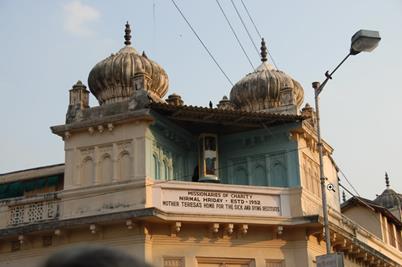Mother Teresa’s Kolkata
….. (1 day)

The Missionaries of Charity’s Mother House stands as a sacred haven, drawing pilgrims and seekers on a quest for a more profound existence. Founded by the Blessed Mother Teresa in 1950, its purpose is rooted in selfless service to humanity, guiding troubled souls toward salvation. Even after Mother Teresa’s departure from her earthly existence in 1997, her tomb within the house serves as a focal point for reverence.
Mother Teresa’s final resting place is a testament to simplicity, radiating an immense and pure vibration that instills gratitude and tranquility in the hearts of those who visit. Despite its location amidst the noise and crowds, the tomb mirrors her life—a paragon of soulful and mindful meditation.
Adjacent to the edifice, the ‘Mother Teresa’s Life, Spirit and Message’ museum showcases artifacts such as her worn sandals, battered enamel dinner bowl, sari, crucifix, rosary, handwritten letters, and spiritual exhortations. The museum provides a tangible connection to Mother Teresa’s life, allowing visitors to delve into the essence of her profound mission.
Preserving the simplicity of ‘Mother’s room,’ a crown-of-thorns adorns her unpretentious camp-bed. This space encapsulates the genuine spirit of Mother Teresa’s life, offering a glimpse into her humble living quarters.
During a visit, prayer petitions can be tenderly placed in the box positioned at Mother Teresa’s Tomb. These petitions are later incorporated into the weekly Friday Mass, where they are reverently offered on the altar.
The Missionaries of Charity’s Mother House stands not only as a physical structure but as a living tribute to the enduring legacy of Mother Teresa—a symbol of unwavering dedication, compassion, and the transformative power of selfless love.

Mother Teresa’s final resting place is a testament to simplicity, radiating an immense and pure vibration that instills gratitude and tranquility in the hearts of those who visit. Despite its location amidst the noise and crowds, the tomb mirrors her life—a paragon of soulful and mindful meditation.
Adjacent to the edifice, the ‘Mother Teresa’s Life, Spirit and Message’ museum showcases artifacts such as her worn sandals, battered enamel dinner bowl, sari, crucifix, rosary, handwritten letters, and spiritual exhortations. The museum provides a tangible connection to Mother Teresa’s life, allowing visitors to delve into the essence of her profound mission.
Preserving the simplicity of ‘Mother’s room,’ a crown-of-thorns adorns her unpretentious camp-bed. This space encapsulates the genuine spirit of Mother Teresa’s life, offering a glimpse into her humble living quarters.
During a visit, prayer petitions can be tenderly placed in the box positioned at Mother Teresa’s Tomb. These petitions are later incorporated into the weekly Friday Mass, where they are reverently offered on the altar.
The Missionaries of Charity’s Mother House stands not only as a physical structure but as a living tribute to the enduring legacy of Mother Teresa—a symbol of unwavering dedication, compassion, and the transformative power of selfless love.

Home of the Pure Heart (Nirmal Hriday), formerly known as Mother Teresa’s Kalighat Home for the Dying Destitutes, stands as a testament to compassion and human dignity. Established by St. Mother Teresa in Kalighat, Kolkata, India, this hospice for the sick, destitute, and dying was founded on her 42nd birthday in 1952, a mere two years after the inception of the Missionaries of Charity in Kolkata.
Situated next to the famous Kalighat Kali Temple in Kalighat, Calcutta, the building originally served as an abandoned Hindu temple dedicated to the goddess Kali, symbolizing time and change. With the assistance of Indian officials, Mother Teresa transformed this once-neglected structure into the “Kalighat Home for the Dying,” a free hospice designed to provide solace and care for the impoverished.
Later, Mother Teresa renamed the hospice to “Kalighat the Home of the Pure Heart (Nirmal Hriday).” The renaming reflected her vision of infusing purity and compassion into the hearts of both those who served and those who sought refuge.
Within the walls of Nirmal Hriday, individuals in their most vulnerable moments received dedicated medical attention from the Missionaries of Charity. More than just a place for physical care, the hospice embraced the diverse religious backgrounds of its residents. Muslims were read verses from the Quran, Hindus received water from the sacred Ganges, and Catholics received the Last Rites. Mother Teresa’s commitment to preserving the dignity of each individual extended to ensuring they could pass away in accordance with the rituals of their faith.
In her own words, Mother Teresa articulated the profound philosophy guiding the hospice: “A beautiful death is for people who lived like animals to die like angels—loved and wanted.” This sentiment encapsulates the essence of Nirmal Hriday, where the destitute and dying found not only physical care but also a place where their humanity was acknowledged, respected, and embraced until their last breaths. The legacy of Mother Teresa and the Home of the Pure Heart continues to inspire acts of kindness, love, and compassion around the world.

Situated next to the famous Kalighat Kali Temple in Kalighat, Calcutta, the building originally served as an abandoned Hindu temple dedicated to the goddess Kali, symbolizing time and change. With the assistance of Indian officials, Mother Teresa transformed this once-neglected structure into the “Kalighat Home for the Dying,” a free hospice designed to provide solace and care for the impoverished.
Later, Mother Teresa renamed the hospice to “Kalighat the Home of the Pure Heart (Nirmal Hriday).” The renaming reflected her vision of infusing purity and compassion into the hearts of both those who served and those who sought refuge.
Within the walls of Nirmal Hriday, individuals in their most vulnerable moments received dedicated medical attention from the Missionaries of Charity. More than just a place for physical care, the hospice embraced the diverse religious backgrounds of its residents. Muslims were read verses from the Quran, Hindus received water from the sacred Ganges, and Catholics received the Last Rites. Mother Teresa’s commitment to preserving the dignity of each individual extended to ensuring they could pass away in accordance with the rituals of their faith.
In her own words, Mother Teresa articulated the profound philosophy guiding the hospice: “A beautiful death is for people who lived like animals to die like angels—loved and wanted.” This sentiment encapsulates the essence of Nirmal Hriday, where the destitute and dying found not only physical care but also a place where their humanity was acknowledged, respected, and embraced until their last breaths. The legacy of Mother Teresa and the Home of the Pure Heart continues to inspire acts of kindness, love, and compassion around the world.

